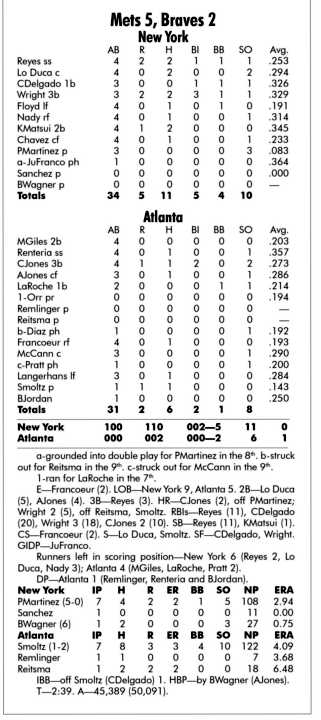The New Ballgame: Understanding Baseball Statistics for the Casual Fan (16 page)
Read The New Ballgame: Understanding Baseball Statistics for the Casual Fan Online
Authors: Glenn Guzzo

We're now seven minutes-and 85 stats-into the show. Time to catch
our breath, er, go to the first commercial.

The whole hour passes this way-video trips from stadium to stadium,
stat-filled graphic scoreboards, and the announcers fast-talking to squeeze
more data into tiny sound bites.
At Yankee Stadium, Baseball Tonight has a film clip and news you won't get anywhere else-it's the third time this month Yankee pitcher Jaret
Wright has been hit with a batted ball. This gets slightly higher billing than
Rodriguez' 46' home run, which ties him with Joe DiMaggio for the most
homers ever by a right-handed hitting Yankee. Like Rodriguez, DiMaggio did
it in his second season as a Yankee, 1937.
The attraction in Colorado is Barry Bonds, who is ever closer to passing Babe Ruth in lifetime home runs. Lifetime against Rockies starter Sunny
Kim, Bonds is 2-for-2 with two home runs. Here's a video highlight from a
Bonds at-bat tonight. He swings and-he grounds out to second. Bonds went
0-for-3 tonight, the Rockies won 6-0, and that's all we need to tell you about
this game between two bottom feeders. Here's a twenty-six-stat scoreboard if
you must know more.
Thanks to stats, the Baseball Tonight crew can create urgency in otherwise meaningless games. The Milwaukee Brewers have reached a .500 record (77-77) with eight games to go, thanks to a seven-run second inning that
chased Cardinals starting pitcher Mark Mulder in the shortest outing of his
career. Kurkjian: The last time the Brewers finished a season .500 was 1992.
In a who-cares game, the New York Mets beat the Washington Nationals. Bet you didn't know this: Nationals pitcher Livan Hernandez hit a triple
off Tom Glavine tonight. It's Hernandez' second triple of his career-and
both have been off Glavine.
The daily treat you've been waiting for: The list of "Today's Home
Runs," with a few golden nuggets of context:
• David Wright's second career grand slam makes him 7-for-13 lifetime with the bases loaded.
• Francoeur's homer was his first since September 3.
• Andruw Jones' 51St home run was his first in eight games: Kurkjian:
"50 home runs for a center fielder: Mays, Mantle, Griffey and Andruw Jones."
• Rodriguez' home run ties DiMaggio's mark.
• Teixeira's homer was Texas' 257t1 this season.
• Ron Belliard became the ninth Cleveland player with at least 15
homers this season. That had never been done before. Now, two
teams have: Cleveland and Texas.
One last commercial break, followed by the show's shortest segment,
but a sweet one: video highlights of today's Web Gems-the day's top defensive plays. This is the only segment of the show where video gets more air
time than stats, but the show's signoff is in numbers:
The last time both leagues had hit streaks as long as 29 games was
1987, when Paul Molitor (39-game streak) and Benito Santiago (34) did it.
The Yankees have now eclipsed four million in attendance. Only two
teams-Colorado and Toronto-have done that previously. From 1951 to
1974, Kurkjian adds, the Yankees never drew more than two million fans.
And that's a wrap, at 11:30 p.m. Eastern Time. The next show is one hour
from now, when, presumably, we'll have final scores from the West Coast.
That's Baseball Tonight.
A BOX SCORE

 espite being
espite being
published in
the smallest
type and squeezed into
narrow spaces, the baseball
box score has earned enduring respect.
Even as newspapers have gotten smaller over the years, they
have not sacrificed the box score to make space. Every web site chronicling
baseball games includes box scores too. This translation of a baseball game
into almost nothing but numbers provides fans with a concise, universal
language to relate the events of a game.
Although the content of box scores has evolved, these grids have been
a staple of game recaps since the 1850s. As baseball statistics have become
more widespread in their use, so too has the box score widened.
The earliest box scores were mostly concerned with runs scored and
outs. In modern baseball, the staples have been a lineup and four columns
showing each batter's at-bats (AB), runs (R), hits (H), and runs batted in (BI).
Some box scores still appear that way, but today's "expanded" box scores
also have a column for season-to-date batting averages (Avg), and possibly
even columns for walks (BB), strikeouts (SO), and men left on base (LOB).
Below that, the pitching grid traditionally contains columns for each
pitcher's innings pitched (IP), hits allowed (H), runs allowed (R), earned runs
allowed (ER), walks, (BB) and strikeouts (SO). Expanded box scores now
have columns for number of pitches thrown (NP) and season-to-date earned
run averages (ERA).
The information between the batting and pitching grids has also expanded, lengthening the box score with a wealth of detail on batting, baserunning, fielding and pitching.
As the box scores are crammed with ever more information, words get
abbreviated-player names get condensed, entries like "three-base hits" have
been shortened to "3B." But the numbers are sacred-none get removed,
more get added.
Saying you are a baseball fan but don't read box scores is kind of like
saying you are Christian but don't read the Bible. Like the Bible, it is never
too late to begin reading box scores. Unfortunately, those who publish box
scores take their readers' knowledge for granted-the boxes seldom appear
with a code explaining all the abbreviations.
We can best teach you how to read a box score by showing you one.
On page 124 is the box score of the New York Mets' 5-2 victory over
the Atlanta Braves on April 28, 2006. It was produced by the Associated Press and published widely in American newspapers. We chose it because this game
was typical, not extraordinary, yet enough went on in this game to show you
most of what you will encounter by reading box scores of many games.
In fact, the amount of information this box score reveals tells us precisely how this game was decided in a dramatic bottom of the ninth inning.

The placement of the New York lineup at the top tells us that the Mets
were the visitors and the Braves were at home.
This is an expanded box score. In addition to the columns for AB, R, H,
BI, we have others for BB, SO and Avg.
The line for New York's leadoff hitter, Jose Reyes, shows that he played
shortstop (ss), had four at-bats, scored two runs, had two hits, had one run
batted in, walked once, struck out once and, after this game, was hitting .253
for the season. Because two hits in four at-bats is a .500 average, we know
that he had been hitting less than .253 before the game.
We see an orderly New York lineup: Eight batter-fielders followed by
the pitcher, Pedro Martinez. Most names are printed last-name-only. Those
displayed with a first initial are those who have the same last name of another
player in the league.
After "PMartinez," we see more players, led by the entry, "a-JuFranco
ph "
That's Julio Franco. We need "JuFranco" because there's another JFran-
co in the league, John Franco. The "ph" tells us Franco was a pinch hitter today, and because his name appears directly beneath Martinez, we know that's who he pinch hit for. The "a-" is explained below the team lineup: "grounded
into double play for PMartinez in the 8t11," meaning the 8th inning.

The next two names belong to pitchers: Duaner Sanchez and Billy Wagner. They didn't bat, but as soon as they entered the game, they were officially
in the lineup. We can check the pitching grid at the bottom of this box score
to see when they pitched and what they did. But let's wait for that while we
follow the box from top to bottom.
Next is the Atlanta lineup and it looks much different from the orderly
New York lineup. The Braves used many more players and at some point the
batting order was scrambled. A good box score, like this one, can help us figure out when and how this happened.
We can confidently suppose that pitchers Mike Remlinger and Chris
Reitsma were not in the original lineup batting seventh and eighth. Aside
from the problem of having two pitchers start the game, we know by looking
at the pitching grid below that Remlinger and Reitsma did not start the game
at all-they relieved starting pitcher John Smoltz, who pitched seven innings.
We also see that the lineup entry "1-Orr pr" is translated this way: "1-ran for
LaRoche in the 7th" So we know that Pete Orr pinch ran for first baseman
Adam LaRoche after LaRoche, batting fifth in the lineup, reached base in
the 7' inning. Finally, we note that Orr did not play a fielding position; he
was only "pr." LaRoche's replacement at first base appears at the bottom of
the grid: Brian Jordan batted in the ninth place of the batting order, the spot
Smoltz once held.
Now we know exactly what happened: After Orr pinch-ran and the
Braves were retired in the 7', Atlanta Manager Bobby Cox replaced both
LaRoche and Smoltz. But Smoltz' position in the batting order would be the first of those two to come up and Cox did not want a pitcher batting there. So
he put Jordan in that spot and put Smoltz' pitching replacement, Remlinger, in
LaRoche's spot. This not only got Jordan to the plate sooner, but gave Cox the
option of keeping Remlinger in the game longer instead of having to pinch
hit for him in the 8'.
